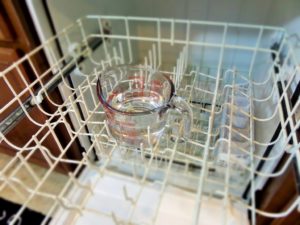Mold. It’s one of those four-letter words that can do more than offend you or give you the creepy crawlies. It can cause serious concerns about the condition of your home and the potential for health-related problems that mold can trigger.
A common mold breeding ground is right inside your dishwasher. Mold thrives in warm, dark, damp places. It also loves leftover food particles and soap residue – so, what’s not to like about a dishwasher.
Luckily, with a little elbow grease and some basic cleaning supplies, you can remove even the most stubborn of mold deposits and keep it from coming back.

-
Start with an empty dishwasher
and remove all racks and silver-wear trays or baskets. Wash the racks and trays by hand with warm soapy water and set aside to dry.
-
Mix 2 cups hot water with ½ cup distilled white vinegar
in a bowl or empty spray bottle, and apply to the moldy areas as well as all seals and crevices where mold might be hiding. Thoroughly scrub the inside of your dishwasher with an old toothbrush or sponge – paying special attention to the underside of the spinning arms – and then rinse with warm water.
-
Place the racks and utensil tray back in the dishwasher.
Pour two cups of vinegar into a small dishwasher-safe bowl or measuring cup and place it upright on the top rack of the dishwasher. Run a full wash cycle on the highest heat setting.
- Finally, sprinkle a cup of baking soda on the dishwasher floor and run a full wash cycle on the highest heat setting a second time. While the vinegar works to kill the mold, the baking soda tackles any mold spores the vinegar may have missed while it deodorizes the interior.
When the job is completed, you can step back and enjoy your shiny clean and fresh-smelling dishwasher. To keep mold from coming back, wipe down any wet areas if you won’t be running the dishwasher for a few days.
At Eagle Service Company, we can stop the spread of mold in your home when the problem stems from a leaking water pipe. So, if you should spot black mold forming on all walls, ceilings, or inside your tub or shower, contact us so we can determine the cause, source, and take the necessary corrective action.


